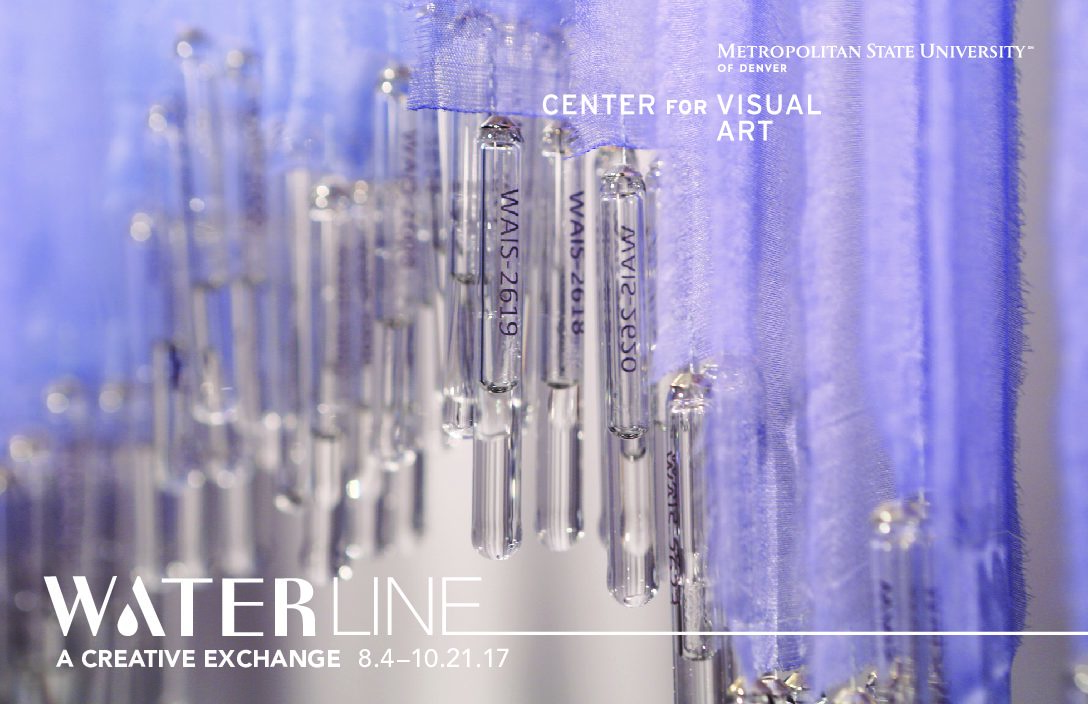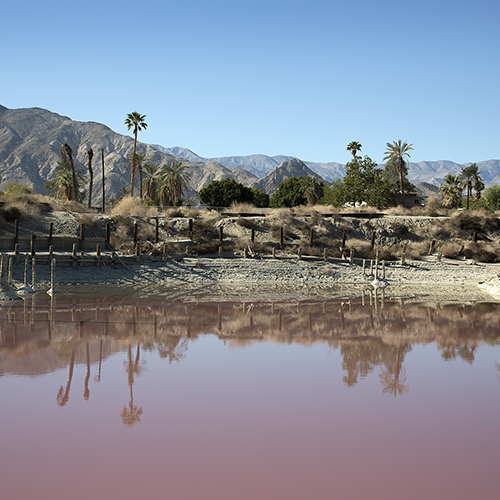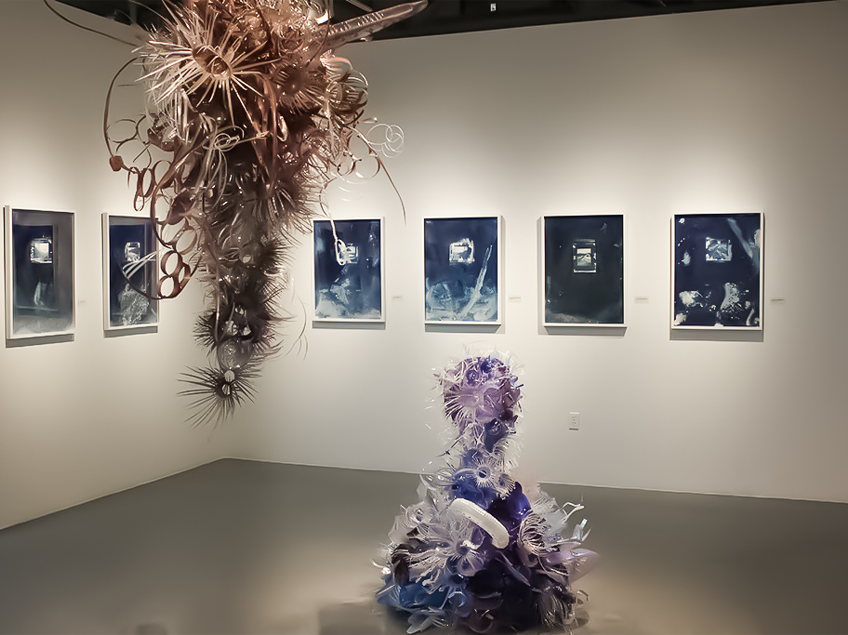
Description
CVA will serve as a hub for an artist-led response to the water crisis. Water Line: A Creative Exchange examines the loaded issue of water and promotes stewardship, advocacy and activism through the work of contemporary artists, and in direct conversation with students, policy analysts, and scientists.
The exhibition will feature artists’ critical responses to institutional and individual actions that contribute to the water crisis, as well as imaginative solutions, practical and not, for addressing the issue. The challenge presented to artists will be to engage audiences in multi-channel dialogue about water, with the intent to make visitors think differently about solutions to this problem that affects everyone, and requires the efforts of all.
Water Line: A Creative Exchange is organized by Metropolitan State University of Denver Center for Visual Art. Collaborators include One World One Water Center for Urban Water Education and Stewardship, and Denver Botanic Gardens.
- Cecily Cullen, Curator
Artists in the Exhibition
Anna McKee
Aurora Robson
Cannupa Hanska Luger
The Infamous Flapjack Affair and National Park Experience
Isabelle Hayeur
Matt Jenkins and Lynna Kaucheck (Food & Water Watch)
Natascha Seideneck
Vibha Galhotra
Winter Count Collective (Cannupa Hanska Luger, Merritt Johnson, Nicholas Galanin, Ginger Dunnill and Dylan McLaughlin)
Tomiko Jones and Jonathan Marquis
Nicholas Galanin
Merritt Johnson
Artist Talks
Artist Cannupa Hanska Luger was born in North Dakota on the Standing Rock Reservation and identifies as Manda, Hidatsa, Arikara, Lakora, Austrian, and Norwegian. A large portion of Cannupa’s work is multi-disciplinary, however, We Have Agency is ceramic-centric.
The art Cannupa creates from their studio in Santa Fe, New Mexico is used as a catalyst to create a larger dialogue that challenges expectations and misinterpretations of indigenous populations imposed by historical and contemporary colonialism. Cannupa has exhibited his work nationally as well as lectured on the topics of cultural appropriation, environmentalism, and the damaging effects of extractive industries. During our time with Cannupa, they spoke about their work We Have Agency and This is Not a Snake as well as the larger installation created by members of the Winter Count Collective.
During a past exhibition at CVA, Cross Currents, Cannupa met Merritt Johnson and Nicholas Galanin who are artists also working to change perceptions of contemporary indigenous art.
These artists, along with other members, formed Winter Count – a collective that cultivates awareness, respect, honor and protection for land and water. This collective worked most notably to create mirrored shield that reflected the law enforcement agencies that opposed indigenous water protectors at the Standing Rock Reservation. For Water Line, the collective presented both works of Cannupa’s alongside work of Merritt and Nicholas providing an engrossing experience that challenges the audience to rethink their impact on the environment and establish the viewer as a global citizen.
Working together since 2014, Nicholas and Merritt have no conceptual or materialistic limitations to their collaborations and this is evident in the work exhibited in Water Line.
The backdrop to their piece, Making an Eye the Better to See You With, is a video that features drone footage of untouched American landscapes while the table shows an unfinished carving of a drone, a prayer mask, incomplete beadwork, and various tools. Both artists perform their work, Nicholas often in character as the “White Carver” and Merritt records her performances, which is why the objects in their installation are unfinished. When juxtaposed with the work of Cannupa, this installation helps provide a complete narrative around water, policy, and stewardship.
The Water Trailer
Recently the Water Trailer parked in CVA’s lot to give art walk guests fresh, clean, cold drinking water from Denver Water. Guests learned about the source of Denver’s water in conjunction with Water Line: A Creative Exchange which examines the loaded issue of water, and promotes stewardship, advocacy, and activism through the work of contemporary artists. This community resource provided by Denver Water served as a catalyst for the conversation around conservation with Stacy Chesney, the Manager of Mida Communications at Denver Water.
Nearly all of Denver’s water comes from mountain snowmelt, the city is also first in line to use water from this source. Dillon reservoir accounts for 37% of Denver’s total capacity for water, other watersheds include the South Platte River, Blue River, Williams Fork River, and Fraser River. In total Denver Water’s collection system covers about 4,000 square miles, or 2.5 million acres, and extends into eight counties. As a citizen and consumer, what can you do to help protect these watersheds and reduce our consumption?
Outdoor watering consumes the most water in a Single Family Home in Denver. Second is the toilet, followed by the shower and washing machine. Denver Water offers a rebate for WaterSense-Labeled toilets and self-audit forms to evaluate how much water is being used in your Bathroom, Kitchen, and Laundry rooms. Also following the Summer Watering Rules can be a great way to change your habits and reduce the amount of water used on landscaping. Denver Water also offers a rebate for customers who have a WaterSense-labeled smart sprinkler system controller and up to a $3 rebate per sprinkler head for rotary/high-efficiency sprinkler nozzles. Following the Summer Watering Rules and auditing your home is a great way to reduce the amount of water used in your home. Reducing your personal consumption and the consumption of your home helps protect watersheds by reducing demand for water as the city’s population continues to grow and the overall demand increases. Learn more about Denver Water on their new website TAP.
One World One Water Center
One World One Water Center (OWOW) is a collaboration between MSU Denver and the Denver Botanic Gardens and strives to prepare an educated, empowered, solution-oriented Colorado citizenry to protect and preserve our precious water resources. Located on the MSU Denver campus, OWOW offers a Water Studies Minor and Certificate that provide students with the skills necessary to become more knowledgeable of Colorado’s limited water resources, and how to preserve this most precious resource. These programs are available to any MSU Denver student regardless of their major. Students from all three aurora campus institutions can join the Water Association of Student Stewards Urban Program (W.A.S.S.U.P.) which aims to discuss and address the spectrum of regional and global water issues. The mission is to show tangible results of the educational benefits of the Water Studies Minor and Certificate provided by the One World One Water Center for Urban Water Education and Stewardship. Through the Minor and Certificate offered at MSU Denver and the tri-institutional WASSUP club One World One Water Center and the Denver Botanic Gardens want to increase the number of participants in the conversations surrounding water policy. Having multiple perspectives and backgrounds enriches the dialogue and creates unique solutions to complex problems.
CVA interviewed Jennifer Riley-Chetwynd, Director of Marketing & Social Responsibility, at the Denver Botanic Gardens about water stewardship. The issues and policies around water can be very complex and hard to navigate. That is why CVA and the Denver Botanic Gardens worked together to reduce the barriers of entry into this conversation through Water Line: a creative exchange. By using art as a vehicle for the message of water stewardship more people are able to start talking about how water affects their lives, their communities, and the world. When art is used to start conversations larger groups are exposed to different perspectives on water and water policy. Whether through art exhibitions or gardens, it is important to highlight the important topic of water stewardship so that more people are involved in the conversations surrounding it. Learn more about the Denver Botanic Gardens and their programs here.
















